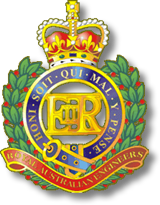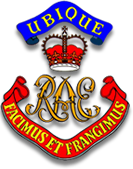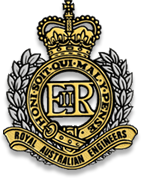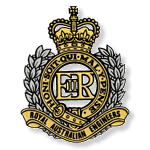1 Field Squadron Group, RAE, Qld Inc.
RAE History
Royal Australian Engineers
A History in Brief

Pre-Federation
When Captain Arthur Phillip arrived at Sydney Cove in 1788 to found the settlement in New South Wales he had to appoint an officer of the garrison to act as 'engineer and artillery officer' to undertake civil and defence works. At the time he set sail from England with his fleet in 1787 there were fewer than 80 Royal Engineer officers and it was not expected that any would be spared for a remote and insignificant part of the world.
Successive governors continued with this arrangement until the first Royal Engineer officer, Captain George Barney, was appointed to the Australian colonies in 1835. Barney's primary duty was of safeguarding and maintaining the building and stores relating to military and convict establishments; however, this was soon overshadowed by civil responsibilities.
The forerunner of the Royal Australian Engineers was the Corps of Victorian Volunteer Engineers founded in the colony of Victoria by Captain (later Major-General Sir) Peter Scratchley, on the evening of Thursday 15 November 1860, at a meeting held at the Duke of Rothesay Hotel in Melbourne. At this meeting the Rules and Regulations of the Victorian Volunteer Engineering were adopted.
The other Australian colonies soon followed suit, and by 1876 five of the six had raised their own engineer units, embracing field, fortress, telegraph, electric, and submarine mining companies. All based their organisation and training on the Royal Engineers. It was these engineer forces that provided many of the volunteers who served in the Sudan Campaign in 1885 and the South African War of 1899-1902.
Post-Federation
On 1 January 1901 the colonies became states of the new Commonwealth. In March their military forces passed to the control of the Commonwealth.
On 1 July 1902 the personnel for the administration of Engineer Services and Instruction, the Permanent, Militia, and Partially-paid Submarine Mining units, and the Militia and Partially-paid Field Companies and Electric Companies of the various States became one corps - the Australian Engineers.
The Engineers at that time comprised a very small regular force of fortress and submarine mining companies, which were primarily concerned, with the coastal defences of the capital cities, and a number of militia units. On 27 September 1907, Royal assent was given for the granting of the title 'Royal' to the regular sappers.
The militia engineers retained the title 'Australian Engineers' until 31 January 1936 when the Corps was constituted as the Corps of Royal Australian Engineers embracing both regular and citizen units.
World War One
The First World War saw the raising of the Australian Imperial Force (AIF) and, as a consequence, the first large expansion of the Corps. Some 40 engineer units were raised. These included field, tunnelling, signal and railway operating companies and squadrons. It was these units which, by serving with distinction in Gallipoli, Sinai, Palestine, France and Belgium firmly, established the identity of the Corps.
On 1 July 1915, members of the Survey Section RAE transferred to the newly raised Australian Survey Corps. It was during this period also that the School of Military Engineering was established at Moore Park in Sydney. It was disbanded at the end of the war and re-established at Liverpool NSW in 1939.
Between the World Wars
After the First World War the Corps reverted to a small regular element of fortress engineers and a number of field companies in the Citizen Military Forces. Limited as they were, they provided the nucleus around which the large engineer force raised in World War Two was based. In 1925, members of the RAE Signals transferred to the newly raised Australian Signals Corps.

World War Two
World War Two was another turning point in the history of the Corps. From a very small pre-war size (233 troops and 1750 militia) it expanded to a total of 32,984 men in 1945.
Some of the many and varied tasks undertaken by sappers in the Middle East theatre of war included clearing the way for the advance in the First Libyan Campaign, keeping the roads open in Greece in spite of German dive bombers, carrying out major demolitions during the withdrawal from Greece, laying minefields and constructing defences at Tobruk, clearing minefields during the El Alamein offensive, and construction of the Haifa-Tripoli railway.
The entry of Japan into the war in 1941 presented the Corps with new, and in many ways, more difficult problems. The redeployment of the 2nd AIF to the South West Pacific not only required adaptation to new techniques and different problems, but also demanded the creation of expanded control elements for the Corps. The appointment of the Engineer-in-Chief with the rank of Major-General and the Directors of Engineer Stores, Fortifications and Works, and Transportation, was the result.
The entry of Japan into the war in 1941 presented the Corps with new, and in many ways, more difficult problems. The redeployment of the 2nd AIF to the South West Pacific not only required adaptation to new techniques and different problems, but also demanded the creation of expanded control elements for the Corps. The appointment of the Engineer-in-Chief with the rank of Major-General, and the Directors of Engineer Stores, Fortifications and Works, and Transportation, was the result.
The terrain, climate and general lack of communications facilities in Malaya, New Guinea and Borneo created problems. Roads, airfields, ports and bases had to be constructed almost every where and, as a consequence, by far the greater part of sapper effort was spent on construction tasks. On the combat engineering side, new techniques had to be developed and mastered for breaching obstacles during assault landing and clearing tunnels and bunkers. The Seria oil installations in Borneo provide an excellent example of the varied tasks undertaken by the sappers. Left a blazing wreck by the Japanese, this oilfield was reconstructed and put into production again by the 9th Division Engineers.

Post World War Two
The size of the Army was drastically reduced after World War Two but a small defence force was maintained in which sappers were well represented. Since that time, engineers have been employed continuously on construction work in Australia, and between 1962 and 1965 a significant contribution was made to Papua New Guinea.
Operational commitments for engineer units and sub units have included Malaya during the Emergency, Borneo during the Indonesian Confrontation, and Vietnam War. Although no Australian Engineer units were deployed during the Korea War, many of the sappers saw service there with the 1st Commonwealth Division.
To meet the commitment in Vietnam, the size of the Army was increased from around 28,000 in 1965, to 45,000 in 1972. This enabled the Corps to maintain a force of approximately 1,000 in Vietnam for most of the time. On conclusion of the Vietnam conflict, Selective National Service ended and the Army was reduced in size. Since that time, significant changes have occurred in the Corps.
Operations in Vietnam had demonstrated the need for a larger combat support element than the Field Squadron and to meet this requirement, Field Engineer Regiments were raised in 1972. About this time also, the Corps lost its responsibility for Water Transport and Engineer Stores.
In 1972, the Army and RAE downsized again and restructured to form Combat Engineer Regiments in each Brigade and Construction Regiments and Squadrons to support land force operations.
In 1996, the Royal Australian Survey Corps was disbanded and the survey and mapmaking elements, along with the remaining personnel, reintegrated with RAE, The topographical survey capability was enhanced with modern geomatic engineering technology, techniques and training and has now become a vital component of the Corps' capabilities.
Sappers have increasingly been involved in overseas deployments in support of humanitarian, defence co-operation and peace keeping duties in the South West Pacific Region, the Middle East, Rhodesia, Namibia, Pakistan/Afghanistan, Kurdistan, Cambodia, Somalia, Rwanda, Bougainville and Mozambique. Sappers are currently serving East Timor and in the Middle East, predominantly Iraq, and Afghanistan.
The Corps of Royal Australian Engineers has come a long way since its humble beginnings in 1860 and is unquestionably proud of its history.

Follow the Sapper.
Make sure you are on our mailing list to receive our bi-annual newsletter and latest updates.